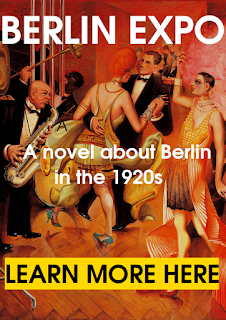A painting by George
Grosz, "Eclipse of the Sun", illustrates an exhibition at
New York’s Neue Galerie about art in the Weimar Republic. Many of
the works are drawn from the collections of the Neue Galerie, and
together they demonstrate the artistic output that coincided with a
moment of extreme political unrest in Germany.
In Eclipse of the
Sun, Grosz vividly captures the rampant political and social
corruption that characterized Germany in the mid-1920s. Set against
the backdrop of a city in flames, the central figure depicted is Paul
von Hindenburg, the nearly-eighty-year-old president of Germany at
the time this was painted, and easily recognizable for his walrus
moustache. He proudly wears his military uniform, bedecked with
medals and with a laurel leaf crown perched atop his bald head.
Hindenburg’s portly physique is in sharp contrast to the group of
slim and headless financiers in formal attire who join him around the
table.
They bask in the
glow of a darkened sun illuminated with a dollar sign—an
acknowledgment of America’s investment in Germany post-World War I.
A corpulent “man of industry,” wearing a top hat and toting
weapons and a miniature train under his arm, whispers discreetly in
Hindenburg’s ear. But Hindenburg has focused his attention
elsewhere—toward a spot just beyond the bloodied sword and funerary
cross resting directly in front of him on the table. Rather
bizarrely, a donkey wearing blinders decorated with the German eagle
is balanced on a board tethered to a skeleton.
The other
participant in this motley group is a more somberly dressed but also
headless man whose foot rests precariously on the prison bars below.
Eclipse of the Sun was one of Grosz’s “favorite pictures” and
it offers a microcosm of the Weimar Republic, alluding to the
competing interests that struggled to control the fledgling
democracy.
The exhibition will
end on September 02, 2019.
 |
| George Grosz, 1919 |
 |
| Rudolf Schlichter, 1923 |
 | |
| Otto Dix, 1929 |
 |
| Otto Dix, 1920 |
 |


No comments:
Post a Comment